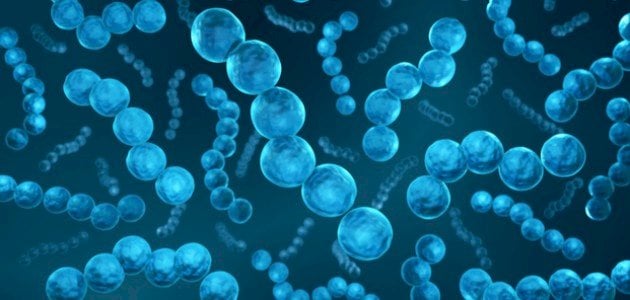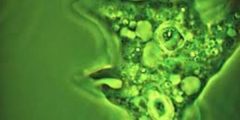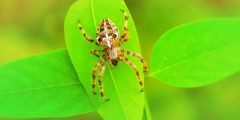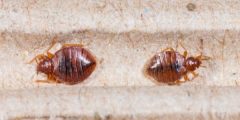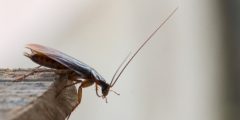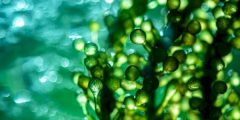Introduction to bacteria
Bacteria are defined as a group of single-celled organisms of small size, and they are considered an important element for the continuation of the biological ecosystem on the planet Earth. In addition, bacteria are distinguished by their ability to live in the most extreme conditions of pressure and temperature. There is no doubt that the human body is filled with bacteria, and most of them are... Beneficial bacteria, not harmful.
There is a very small percentage of harmful bacteria that cause diseases, but most types of bacteria can be classified as beneficial, and bacteria contain a large number of cells that are 10 times the number of human cells.
Types of bacteria
Bacteria are divided into 5 types based on their shape. The following is a detailed explanation of the characteristics of each type of bacteria:
Spherical bacteria
Spherical bacteria are characterized by their spherical shape, hence their name. Their scientific name is cocci. This type of bacteria is characterized by its presence in the form of pairs, including pneumococci, which usually cause pneumonia, and gonococci, which cause gonorrhea. This can be likened to A type of bacteria with a long string of beads.
Bacillus bacteria
Bacillus bacteria are one of the types of bacteria with a cylindrical shape, and their scientific name is Bacilli. They are usually found in the form of square or cubic bundles, and most of them are characterized by the presence of pointed ends, and some strains of this type are distinguished by their presence in the form of long strains.
Read also:Name of male antVibrio bacteria
Vibrio bacteria are characterized by being shaped like rods with curved bends, and their name resembles a comma. An example of them is the cholera bacterium, which causes cholera, and its scientific name is Vibrius.
spirochete bacteria
Spirochaete bacteria are scientifically called (in English: Spirochaete). They are characterized by their thin and long shape, and usually move in a circular manner to allow themselves to enter the lined tissues and sticky places. This type of bacteria causes tick disease.
Helicobacter pylori
Spiral bacteria are scientifically called Spirilla, and they are characterized by their spiral shape that resembles a key, as the spiral cell body is wrapped around the central fiber called the axial filament.
Bacteria behavior
Bacteria are active organisms in the environment they are in, regardless of their type or conditions. Upon their arrival in a new environment, they begin to carry out a set of behaviors and activities, the most important of which are:
Secretion
Bacteria constantly secrete a group of chemicals that work to prepare the environment and modify it to suit their way of living. This chemical is often a group of proteins that have the properties of enzymes in their ability to analyze and digest a number of foods available around them.
Read also:A single-celled organismBioluminescence
Some types of bacteria that live in water are characterized by bioluminescence behavior, which is based on the bacteria producing light that attracts various marine organisms towards them.
social behavior
Bacteria are often found together as multicellular organisms, performing their various functions within cooperative social behavior, which helps them achieve cell division and achieve some things that bacteria with a single cell cannot achieve, in addition to forming a deterrent line of defense against threats to their existence. And increase their ability to form new types.
the movement
Bacteria move in different ways depending on their types. Some of them have flagella that enable them to move in a liquid environment, while others rely on sliding movement and movement by twitching.
Location of bacteria
Bacteria live in all places on the surface of the Earth, as they are found in many places. The following is an explanation of the most important areas where bacteria are found:
- They are found in soil, between rocks, and in oceans.
- Inside the Arctic snow.
- Inside the bodies of some living organisms, such as humans, where they are found, for example, within their digestive system.
- Found in dead plants; To recycle nutrients.
Methods of feeding bacteria
Methods of feeding bacteria are divided into two methods, and the following is an explanation of these methods:
Read also:Research on fungiAutotrophic
Autotrophic bacteria obtain their food through multiple methods, unlike heterotrophic bacteria that depend only on organic compounds for their food. Below are a number of feeding methods for autotrophic bacteria:
- Optical energy conversion
Bacteria absorb light energy, then use it in the process of photosynthesis in order to generate cellular energy. If oxygen is produced in this way, it is called aerobic nutrition, but if oxygen is not produced, it is called anaerobic nutrition.
- Chemical energy conversion
Bacteria obtain chemical energy from the place around them, then they convert this energy into adenosine triphosphate that they use in their cellular functions. Examples of these include sulfur bacteria, which are originally chemical compounds that can produce energy through the oxidation of hydrogen sulfide in the elements water and sulfur. This can be explained The process is a form of chemical synthesis.
- Inorganic compounds
Bacteria obtain their food through inorganic compounds, and obtain cellular carbon through carbon dioxide, as these bacteria reduce carbon and convert it into necessary sugars through the use of hydrogen sulfide, ammonia, or hydrogen gas. Nitrifying bacteria are one of the types of bacteria that Use this method.
Heterotrophic
Heterotrophic bacteria depend on absorbing organic molecules in order to obtain the necessary energy, just like animals and fungi that eat other types of living organisms. Heterotrophic bacteria usually search for organic sources of carbon, and among these sources are: Fats, sugars, and amino acids, examples of which are saprophytic bacteria.
Saprophytic bacteria use enzymes to obtain their food from dead organic matter, as they use the property of breaking down complex compounds in order to extract energy. This type of bacteria is usually called decomposers, and they have a major role in the ecosystem due to their ability to find simple-structured materials that can Plants and animals benefit from them.
Ways bacteria reproduce
Bacteria reproduce in multiple ways, and the following is an explanation of their methods of reproduction:
Binary fission
The idea of binary fission is based on the division of a single cell into two equal cells. At the beginning of division, the cell has a cellular structure and component. Then the DNA reproduces by separating the strands, so that new complementary strands begin to form on top of the original strands, then an identical nucleic acid (in English: DNA) is produced. And double, and this method is the fastest method of reproduction, as the cell divides within 20-30 minutes.
Reproduction by spores
This method occurs in conditions characterized by drought and lack of nutrients necessary for bacteria, as spores are formed inside the bacterial cell due to the formation of germs inside it, and when germination occurs, a new bacterial cell is produced.
Reproduction by cysts
Bacteria reproduce in cysts by depositing an additional layer around the wall of the mother cell. Over time, these cysts begin to behave similar to the behavior of the mother cell. Examples of bacteria that reproduce in cysts include nitrifying bacteria.
budding
Bacteria reproduce by budding when a small bud begins to form on one side of the cell. Over time, the size of the bud begins to increase little by little until it becomes the size of the mother cell. At this stage, the bud separates from the mother cell, forming a new cell.
Conidia reproduction
Conidia are formed in the highest part of the bacteria, and after their separation from the mother, what is called the conidium is produced. When it comes into contact with the lower layers, which are a suitable place for reproduction, new fungi begin to appear.
Benefits of bacteria
Bacteria include a large number of benefits, the most prominent of which are:
- Digestion of food in the human digestive system.
- Some types produce oxygen gas, which can be used in the manufacture of antibiotics.
- Entering into the process of manufacturing foods that require fermentation, such as yogurt.
- Analyzing corpses and dead bodies, as this contributes to the continuity of the ecosystem’s functioning.
- Releasing carbon dioxide that enables plants to grow.
Bacteria damage
The following are the most important harms caused by bacteria:
- Producing toxins within the body in which they make their home and reproduce.
- Causing damage to human body tissues.
- Causing some diseases such as sore throat, staph infection, cholera, and tuberculosis.
- Sometimes causing cases of food poisoning.
